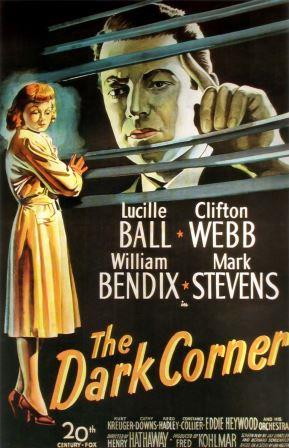“There goes my last lead. I feel all dead inside. I’m backed up in a dark corner, and I don’t know who’s hitting me.”—Bradford Galt (Mark Stevens)
First, throw together, or rather carefully conceive and choreograph, a street thug, a couple of society criminals, a duplicitous wife and a pair of opposite personalities for partners—a pessimistic detective and his pretty, upbeat secretary. Now add the no-nonsense direction of Henry Hathaway, the chiaroscuro cinematography of Joseph MacDonald and the hard-nosed screenplay of Jay Dratler and Bernard Schoenfeld and the result is a succulent little film noir . . . The Dark Corner.
20th Century-Fox made some of the best noir films during that gold-mine period of the 1940s and early ’50s. True, the best of Warner Bros. are hard to beat—The Maltese Falcon (1941), The Big Sleep (1946) and White Heat (1949)—and are, perhaps, more famous. But Fox, though they started later, did have Laura (1944), The House on 92nd St. (1945), Nightmare Alley (1947), Call Northside 777 (1948), Where the Sidewalk Ends (1950) and any number of others.
Some of the featured stars seemed perfect for the genre—Richard Widmark and Richard Conte—and others, generally trademarked in heroic or comic roles—Tyrone Power and James Stewart—became as effective as anyone slipping among the dark shadows and sleazy joints of film noir.
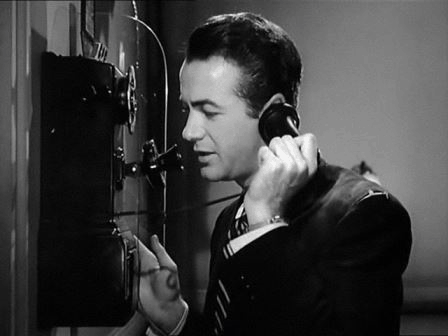 The Dark Corner is often overlooked, but it clearly belongs, if not among the best, then among the more interesting of Fox’s explorations of bleak atmospheres and paranoid souls. Against the all-convincing angst of, say, a Humphrey Bogart, Mark Stevens as the miserably disheartened detective may be too negative to convey a strong character that sometimes depresses the audience in the process. Two other stars, one playing against type and the other reviving the character that brought him stardom, easily steal a greater portion of the limelight from Stevens.
The Dark Corner is often overlooked, but it clearly belongs, if not among the best, then among the more interesting of Fox’s explorations of bleak atmospheres and paranoid souls. Against the all-convincing angst of, say, a Humphrey Bogart, Mark Stevens as the miserably disheartened detective may be too negative to convey a strong character that sometimes depresses the audience in the process. Two other stars, one playing against type and the other reviving the character that brought him stardom, easily steal a greater portion of the limelight from Stevens.
People forget that Lucille Ball had been in the movies since 1933, only receiving consistent screen credit beginning in 1937, making mostly unremarkable movies and numerous comedies. Even opposite some of the big male stars—William Holden, Fred Astaire, Bob Hope, Ray Milland, Red Skelton—the result was little recognition. Little, that is, until the rocket success of I Love Lucy and a career that was largely devoid of theatrical movies, and forever away from dramatic roles for which she had a certain flair.
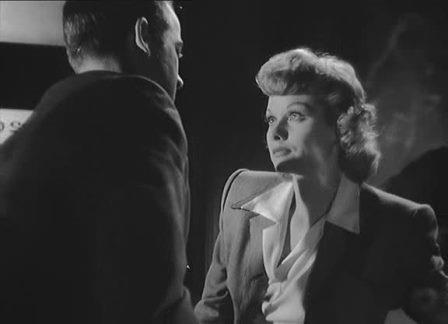 In The Dark Corner she is confident and vivacious, taking charge, often encouraging her gloomy detective-boss when he himself seems ready to give up. No revelation can weaken her devotion to him—not even him telling her he once served two years in prison for manslaughter, framed by one of the story’s characters, who plied him with scotch and put him behind the wheel of a car that hit and killed a truck driver.
In The Dark Corner she is confident and vivacious, taking charge, often encouraging her gloomy detective-boss when he himself seems ready to give up. No revelation can weaken her devotion to him—not even him telling her he once served two years in prison for manslaughter, framed by one of the story’s characters, who plied him with scotch and put him behind the wheel of a car that hit and killed a truck driver.
The other scene-stealing actor, with perhaps more charisma, more nuances in his facial expression and certainly wittier than Mark Stevens, whose forte is hardly witticisms, is Clifton Webb. He had made a few movies since 1917 before gaining recognition in his first sound film, Laura.
Once again the actor is playing the sophisticated, erudite intellectual, a warmed-over Waldo Lydecker from the earlier Laura, there a newspaper columnist and radio host, now, in The Dark Corner, art devotee and gallery owner Hardy Cathcart. And from that same year, 1946, Webb is the snobbish dinner host in The Razor’s Edge. Years later, in 1954, Webb would be the expatriate author in Rome, John Frederick Shadwell, another eccentric with a way with words.
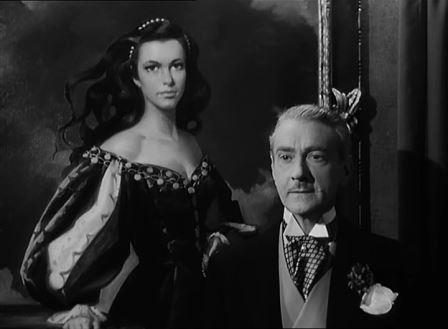 In The Dark Corner, Webb’s barbs are priceless. Isolated from this particular film, they could come from any number of his films. To one of his partners in crime: “The wife of the Austrian critic. She looks like she’s been out in the rain feeding the poultry.” And later to the same man: “How I detest the dawn. The grass always looks like it’s been left out all night.” Commenting on the party crowd gathering at his home: “A nauseating mixture of Park Avenue and Broadway. It proves I’m a liberal.”
In The Dark Corner, Webb’s barbs are priceless. Isolated from this particular film, they could come from any number of his films. To one of his partners in crime: “The wife of the Austrian critic. She looks like she’s been out in the rain feeding the poultry.” And later to the same man: “How I detest the dawn. The grass always looks like it’s been left out all night.” Commenting on the party crowd gathering at his home: “A nauseating mixture of Park Avenue and Broadway. It proves I’m a liberal.”
Immediately after, once again, 20th Century-Fox’s unofficial theme song, “Street Scene,” behind the main title, MacDonald’s ever-distinctive camera swings down from a passing El train to an overhead shot of a man in a white suit (William Bendix) leaning against a lamppost. As the noise of the train vanquished the Alfred Newman tune, now only street noises remain. The white suit is eyeing a painter, who has about finished lettering a second-story window, “Bradford Galt, private detective.”
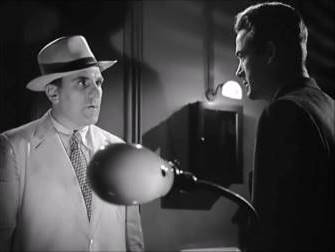 As a man, obviously not in a white suit, climbs the stairs and enters the Galt office, dark shadows and his wary glances imply criminal intent. He is, however, Police Lieutenant Frank Reeves (Reed Hadley), come to warn Galt to stay on the “straight and narrow,” now restarting his private eye business after that prison time. In meeting Kathy (Ball) and inquiring about Galt, she answers tartly, “I sharpen pencils, do the typing, answer the phone and mind my own business.” (In Hadley’s few scenes, he has a mystique somehow stronger than Stevens’, and it could be wondered how he would have been as Bradford Galt.)
As a man, obviously not in a white suit, climbs the stairs and enters the Galt office, dark shadows and his wary glances imply criminal intent. He is, however, Police Lieutenant Frank Reeves (Reed Hadley), come to warn Galt to stay on the “straight and narrow,” now restarting his private eye business after that prison time. In meeting Kathy (Ball) and inquiring about Galt, she answers tartly, “I sharpen pencils, do the typing, answer the phone and mind my own business.” (In Hadley’s few scenes, he has a mystique somehow stronger than Stevens’, and it could be wondered how he would have been as Bradford Galt.)
After Reeves has left, Galt invites Kathy to dinner. “Is this part of the job?” she asks. “It is tonight.” “Working conditions,” she adds, “are certainly looking up around here.”
As they play games at an arcade—she beating him—their quick badinage continues (the audience can clearly sense an attraction between the two, certainly on her part). She would make a fine detective: she leans over to warn him of a man in a white suit who has been following them. “Yeah, I know,” he replies. Ah, he might make a detective, too!
And so the plot continues, gradually darkening in noir fashion, marked by four scenes of violence. After the arcade scene, Galt doubles back to surprise white suit with a gun. In his office, Galt throws the man against a wall and uses a choke-hold to wring information from him. The name he provides is Fred Foss, later revealed as Stauffer.
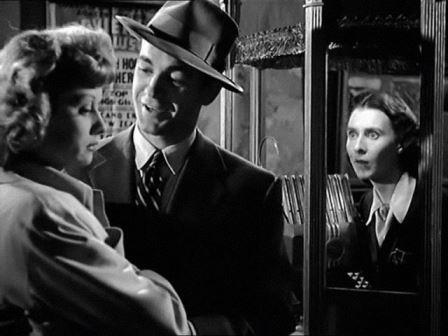 After Cathcart has overheard and seen on the floor the shadow of his wife Mari (Cathy Downs) kissing Jardine (Kurt Kreuger), he sends Foss to kill Jardine. The fireplace poker Foss used, he places in Galt’s hand after he has rendered the detective unconscious with ether.
After Cathcart has overheard and seen on the floor the shadow of his wife Mari (Cathy Downs) kissing Jardine (Kurt Kreuger), he sends Foss to kill Jardine. The fireplace poker Foss used, he places in Galt’s hand after he has rendered the detective unconscious with ether.
Foss naively agrees to meet Cathcart on the thirteen floor of a skyscraper for his payoff. When Foss stoops to pick up a paper intentionally dropped by his boss, Cathcart shoves him out the window.
In the film’s final set piece in the art gallery, Cathcart confronts his wife, who has stashed her luggage, waiting for the never-to-arrive Jardine and their planned escape together. Cathcart, aware of Mari’s infidelity and speaking only in innuendo, delivers his final epigram: “Love is not the exclusive province of adolescence, my dear. It’s a heart ailment that strikes all age groups—like my love for you. My love for you is the only malady I’ve contracted since the usual child diseases. And it’s incurable.”
Galt has gained access to the gallery under the pretense of buying a $40,000 statue, but Cathcart pulls a gun and is about to kill him when Mari, in stark silhouette from the top of the stairs, shoots him dead. Webb’s wide-eyed, surprised expression as he collapses recapitulates Waldo Lydecker’s demise in Laura.
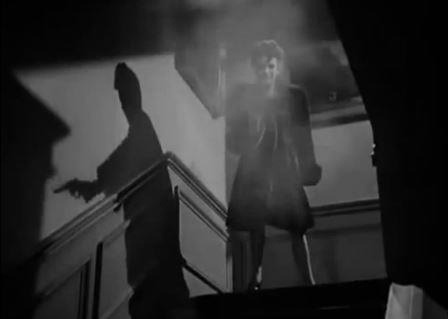 The “Street Scene” melody, absent from the soundtrack since the main title, returns as Kathy and Galt leave for city hall and the justice of the peace. She tells Reeves, who is there to congratulate Galt, “Brad hasn’t asked me yet, but I told him from the beginning I was playing for keeps.”
The “Street Scene” melody, absent from the soundtrack since the main title, returns as Kathy and Galt leave for city hall and the justice of the peace. She tells Reeves, who is there to congratulate Galt, “Brad hasn’t asked me yet, but I told him from the beginning I was playing for keeps.”
The plot of Dark Corner is just short of complicated, complex enough to keep the audience guessing. In the ’40s, no studio could do better than Fox in the luscious, often extravagant contemporary interiors, with brilliant chandeliers, curving staircases and elegantly attired guests.
Good and attention-holding, but not first tier among the studio’s noir films. While sharp and succinct, the dual script of Dratler, who co-wrote Laura, and Schoenfeld could have been more original, less, at times, a compendium of noir clichés. The acting is generally quite substantial, especially from Ball, Webb and Bendix, though Cathy Downs is nothing more than a bland ornament on screen and Mark Stevens could have invested a little more drama, dynamism and humanity in his role.
[embedyt] https://www.youtube.com/watch?v=OP4inToUMlQ[/embedyt]
